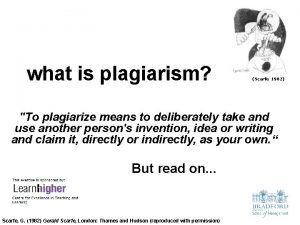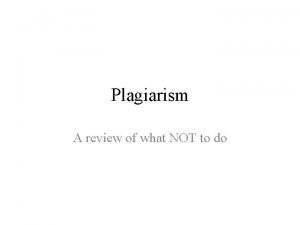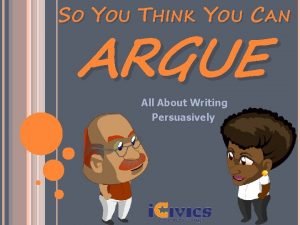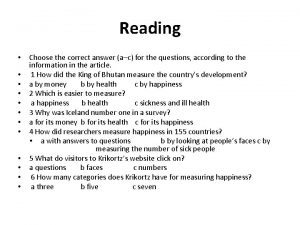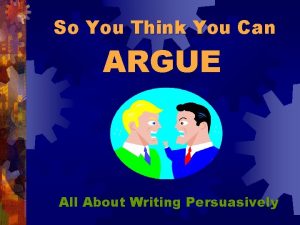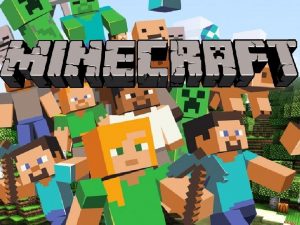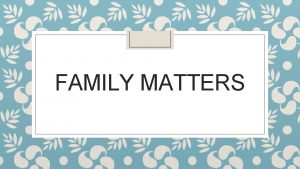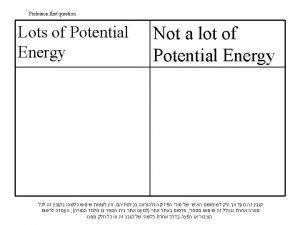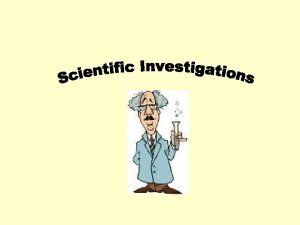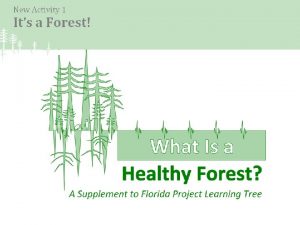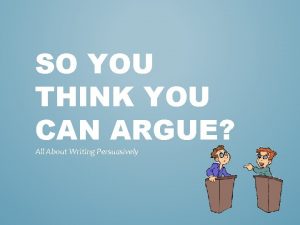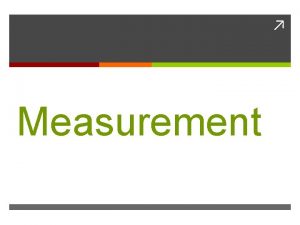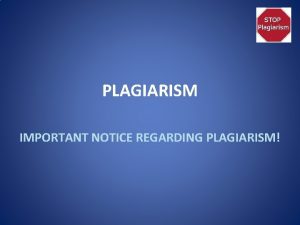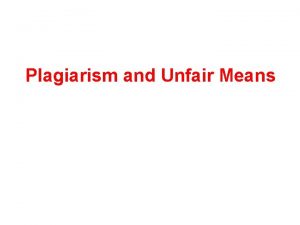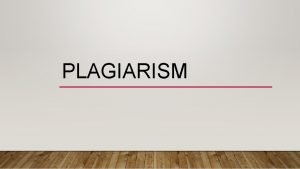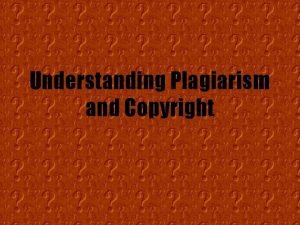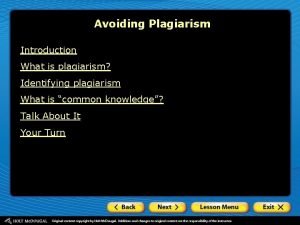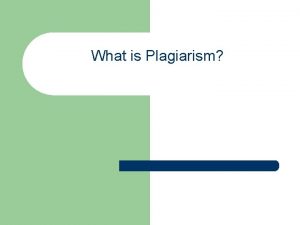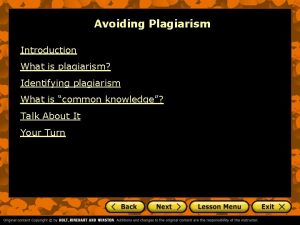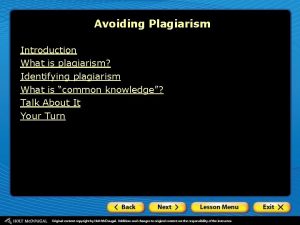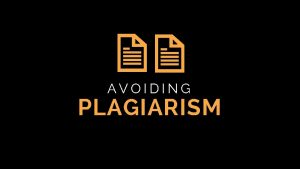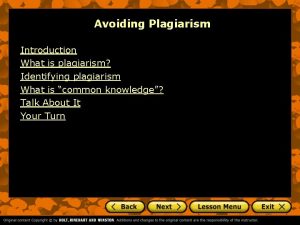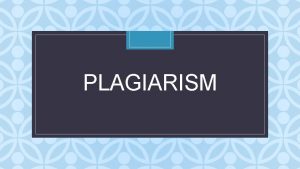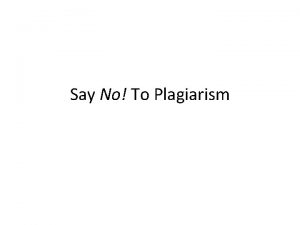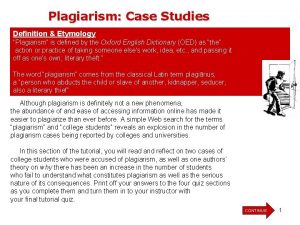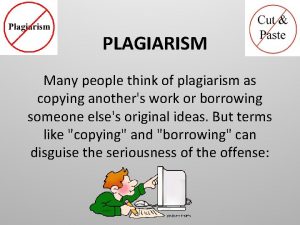What Do You Think Plagiarism Means Plagiarism Defined





















- Slides: 21

What Do You Think Plagiarism Means? Plagiarism Defined

*Copying word for word (verbatim) directly from a source without proper citation. 4 Informational passages 4 statistics, charts, tables, graphs 4 opinions and judgments 4 arguable assertions or facts not commonly known

Plagiarism also means. . . 4 Paraphrasing-even if words are changed and reorganized, a citation is required. 4 Summarizing-even if there is a concise or “boiled down” rewrite, a citation of original source is required.

What is not Plagiarism? 4 Common knowledge 4 Obvious simple facts

What is not Plagiarism? 4 Facts available in a wide variety of sources. 4 Simple, non-specific, general data.

Defense Against Plagiarism 4 Understanding what 4 Summarizing skills plagiarism really means 4 Use of proper citation strategies-APA Style Guide 4 Paraphrasing techniques 4 Research methods – note taking – outlining data – rough drafting

Paraphrasing 4 Restatement of 4 Steps: – read source passage information from books, articles and other reference sources in your own words and writing style. – – carefully. Reread if needed. Be certain of meaning-look up unfamiliar words. Ask for another’s interpretation Identify main idea Identify speaker, material type, and source Paraphrase should be the same length as the original or slightly less

Summarizing Restatement of information in a condensed form. 4 “boil down” 4 “get to the bottom line” 4 “the heart of the matter” 4 “to find the core” 4 “to know the essence” 4 “to get the basics” 4 “to grab the 411”

Steps to Summarize 4 Read material carefully 4 Create a paragraph from and mark main ideas. 4 Read again and mark supporting ideas. 4 Write a paraphrased sentence on each main point. 4 Combine supporting ideas in a paraphrased sentence or two. these sentences. *Put in logical order *Use transitions 4 Product must be significantly shorter than original. 4 Check summary for key points covered, logical flow, and clarity.

When is it best to use direct quotations? 4 Vivid, memorable, or clever wording that makes a strong impression on the reader 4 expert or high praised authority-their exact works have power 4 highlight another’s opinion

Samuel Clemens aka Mark Twain “Adam was the only man who, when he said a good thing, knew that nobody had said it before him. ”

Paraphrasing Practice: Follow the paraphrasing steps and restate this passage. The art involved in popping corn is at least five thousand years old, perfected by the American Indians. They clearly appreciated the difference between sweet corn (for immediate eating), field corn (as cattle feed), and so-called Indian corn, which has sufficient water content of popping. Charles Panati, Extraordinary Origins of Everyday Things.

The Paraphrased Product: According to Charles Panati’s definitive book on the unusual origin of common, household items, Native Americans have popped corn for five thousand years or more. They knew and used sweet corn-eaten without cooking, field corn-for livestock, and what is know as Indian corn-used for popping because it contains water.

Summarizing Practice: 4 Read the original text of Charles Panati again. 4 Follow the summary creation steps. 4 Model: – Native Americans have eaten corn raw, popped it, and fed it to cattle for five thousand years or more.

Share your summaries with the class.

Academic Integrity (Plagiarism and Cheating) 4 If a teacher determines that plagiarism or cheating has occurred, academic sanctions and disciplinary consequences will be implemented. Such consequences will include… 4 No credit for assignment 4 Referral and suspension

Dysart Handbook Plagiarism Statement: 4 Plagiarism will be considered as the use of another person’s original work, regardless of quantity (e. g. one sentence, paragraph, entire text, or product) whether done deliberately or not. 4 In using quotation/citations from the work of another individual, students will be required to follow the teacher’s instructions and grading rubric for each assignment.

Be honorable and trustworthy.

Establishing Credibility TRUST and RESPECT 4 Ethos is writing- Ancient Greeks believed that human character was embodied in man’s word. 4 “My word is my bond!”

Establishing Credibility TRUST and RESPECT 4 Ethos in writing- 4 “You have my word Ancient Greeks believed hat human character was embodied in a man’s word. 4 “My word is my bond!” on it!” 4 I get the last word. ” 4 Ethics/ethos-moral custom or values 4 “Do the right thing!”

This concludes your plagiarism Power. Point presentation.
 Mukesh ambani signature
Mukesh ambani signature If you think you can you can poem
If you think you can you can poem Well defined objects
Well defined objects Plagiarism means
Plagiarism means Mosaic plagiarism means
Mosaic plagiarism means Plagiarism
Plagiarism Why according to robin and jay are people funny
Why according to robin and jay are people funny Think fam think
Think fam think Have a daughter so you can argue
Have a daughter so you can argue Choose the correct answers a-c what do you think
Choose the correct answers a-c what do you think Alan and susie an argument
Alan and susie an argument Do you know about minecraft
Do you know about minecraft What comes to your mind when you hear the word family
What comes to your mind when you hear the word family You have more potential than you think
You have more potential than you think What do you think of when you hear the word science?
What do you think of when you hear the word science? What do you think of when you hear
What do you think of when you hear So you think you can argue
So you think you can argue Quadrilateral pentagon hexagon octagon
Quadrilateral pentagon hexagon octagon Meta means and morphe means
Meta means and morphe means Meta means change and morph means heat
Meta means change and morph means heat Biodiversity conservation definition
Biodiversity conservation definition Bio means life logy means
Bio means life logy means



